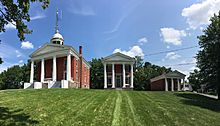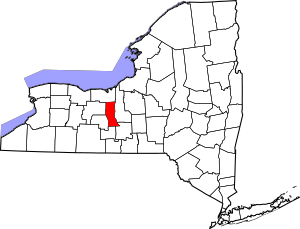Seneca County, New York facts for kids
Quick facts for kids
Seneca County
|
|||
|---|---|---|---|

Historic Seneca County Courthouse Complex at Ovid
|
|||
|
|||

Location within the U.S. state of New York
|
|||
 New York's location within the U.S. |
|||
| Country | |||
| State | |||
| Founded | 1804 | ||
| Named for | Seneca people | ||
| Seat | Waterloo and Ovid | ||
| Largest CDP | Seneca Falls | ||
| Area | |||
| • Total | 390 sq mi (1,000 km2) | ||
| • Land | 324 sq mi (840 km2) | ||
| • Water | 67 sq mi (170 km2) 17% | ||
| Population
(2020)
|
|||
| • Total | 33,814 | ||
| • Density | 104.5/sq mi (40.3/km2) | ||
| Time zone | UTC−5 (Eastern) | ||
| • Summer (DST) | UTC−4 (EDT) | ||
| Congressional district | 23rd | ||
Seneca County is located in the U.S. state of New York. As of the 2020 census, the population was 33,814. The primary county seat is Waterloo, moved there from the original county seat of Ovid in 1819. It became a two-shire county in 1822, which currently remains in effect and uses both locations as county seats although the majority of Seneca County administrative offices are located in Waterloo. Therefore, most political sources list only Waterloo as the county seat. The county's name comes from the Seneca Nation of the Haudenosaunee (Iroquois), who occupied part of the region.
Seneca County comprises the Seneca Falls, NY Micropolitan Statistical Area, which is also included in the Rochester-Batavia-Seneca Falls, NY Combined Statistical Area.
Contents
History
The area covered by Seneca County straddles the prehistoric territories of both Seneca and Cayuga Nations of the Iroquois League. When counties were established by Europeans in New York in 1683, the present Seneca County was part of Albany County. This was an enormous county, including the northern part of New York as well as all of the present state of Vermont and, in theory, extending westward to the Pacific Ocean. This county was reduced in size on July 3, 1766 by the creation of Cumberland County, and further on March 16, 1770 by the creation of Gloucester County, both containing territory now in Vermont.
On March 12, 1772, what was left of Albany County was split into three parts, one remaining under the name Albany County. One of the other pieces, Tryon County, contained the western portion (and thus, since no western boundary was specified, theoretically still extended west to the Pacific). The eastern boundary of Tryon County was approximately five miles west of the present city of Schenectady, and the county included the western part of the Adirondack Mountains and the area west of the West Branch of the Delaware River. The area then designated as Tryon County now includes 37 counties of New York State. The county was named for William Tryon, colonial governor of New York.
In the years prior to 1776, most of the Loyalists in Tryon County fled to Canada. In the fall of 1779 on orders from commander-in-chief General George Washington the Sullivan Expedition conducted a scorched earth campaign against the Iroquois who sided with the Loyalists in the Revolutionary War. Sullivan's path destroyed Cayuga and Seneca villages along the east shore of Seneca Lake.
In 1784, following the peace treaty that ended the American Revolutionary War, the name of Tryon County was changed to Montgomery County in honor of the general, Richard Montgomery, who had captured several places in Canada and died attempting to capture the city of Quebec, replacing the name of the hated British governor.
In 1789, Montgomery County was reduced in size by the splitting off of Ontario County. The actual area split off from Montgomery County was much larger than the present county, also including the present Allegany, Cattaraugus, Chautauqua, Erie, Genesee, Livingston, Monroe, Niagara, Orleans, Steuben, Wyoming, Yates, and part of Schuyler and Wayne counties.
Herkimer County was one of three counties split off from Montgomery County (the others being Otsego and Tioga counties) in 1791.
Onondaga County was formed in 1794 by the splitting of Herkimer County.
Cayuga County was formed in 1799 by the splitting of Onondaga County. This county was, however, much larger than the present Cayuga County. It then included the present Seneca and Tompkins counties and part of Wayne County.
In 1804, Seneca County was formed by the splitting of Cayuga County.
In 1817, Seneca County was reduced in size by combining portions of Seneca and the remainder of Cayuga County to form Tompkins County. Part of this territory, the current towns of Covert and Lodi, were returned to Seneca County in 1819.
The original county seat of Seneca County was located in Ovid, where a court house was constructed in 1806. After southern portions of the county were removed in 1817 to become part of Tompkins County, the seat was moved to Waterloo as the village was more geographically centered at the time. In 1823, northern portions of the county were removed to form part of Wayne County. This put Waterloo in the same situation as Ovid with being on one end of Seneca County. A compromise was made to use both locations as county seats, becoming a two-shire county. It included the constitution of two county courts and jury districts under Chapter 137 of the New York State Laws of 1822. In 1895, the Seneca County Board of Supervisors voted to abolish the setup of two jury districts. It later voted to remove the two-shire county system in 1921, making Waterloo the only county seat, but was reinstated two years later. At least once a year, the County Board of Supervisors holds it's monthly meeting in Ovid to maintain the two-shire status.
In 1823, Seneca County was reduced in size by combining portions of Seneca and Ontario counties to form Wayne County.
Geography
According to the U.S. Census Bureau, the county has a total area of 390 square miles (1,000 km2), of which 324 square miles (840 km2) is land and 67 square miles (170 km2) (17%) is water.
Seneca County is in the western part of New York in the Finger Lakes Region, bounded on the east by Cayuga Lake and on the west by Seneca Lake.
The Finger Lakes National Forest is in the south part of the county.
Both the New York State Thruway and the Erie Canal cross the northern part of the county.
The former Seneca Army Depot occupies a portion of land between Cayuga and Seneca Lakes. The Willard Drug Treatment Center and Five Points Correctional Facility are two New York State prisons located in the county. Sampson State Park is located next to the former Army base.
Adjacent counties
- Wayne County - north
- Cayuga County - east
- Tompkins County - southeast
- Schuyler County - south
- Yates County - southwest
- Ontario County - west
Major highways
 Interstate 90 (New York State Thruway)
Interstate 90 (New York State Thruway) U.S. Route 20
U.S. Route 20 New York State Route 5
New York State Route 5 New York State Route 89
New York State Route 89 New York State Route 96
New York State Route 96 New York State Route 96A
New York State Route 96A New York State Route 414
New York State Route 414- New York State Route 336
National protected areas
- Finger Lakes National Forest (part)
- Montezuma National Wildlife Refuge (part)
- Women's Rights National Historical Park
Demographics
| Historical population | |||
|---|---|---|---|
| Census | Pop. | %± | |
| 1810 | 16,609 | — | |
| 1820 | 23,619 | 42.2% | |
| 1830 | 21,041 | −10.9% | |
| 1840 | 24,874 | 18.2% | |
| 1850 | 25,441 | 2.3% | |
| 1860 | 28,138 | 10.6% | |
| 1870 | 27,823 | −1.1% | |
| 1880 | 29,278 | 5.2% | |
| 1890 | 28,227 | −3.6% | |
| 1900 | 28,114 | −0.4% | |
| 1910 | 26,972 | −4.1% | |
| 1920 | 24,735 | −8.3% | |
| 1930 | 24,983 | 1.0% | |
| 1940 | 25,732 | 3.0% | |
| 1950 | 29,253 | 13.7% | |
| 1960 | 31,984 | 9.3% | |
| 1970 | 35,083 | 9.7% | |
| 1980 | 33,733 | −3.8% | |
| 1990 | 33,683 | −0.1% | |
| 2000 | 33,342 | −1.0% | |
| 2010 | 35,251 | 5.7% | |
| 2020 | 33,814 | −4.1% | |
| U.S. Decennial Census 1790-1960 1900-1990 1990-2000 2010-2020 |
|||
As of the census of 2010, there were 35,251 people, 13,393 households, and 8,762 families residing in the county. The population density was 103 people per square mile (40/km2). There were 14,794 housing units at an average density of 46 per square mile (18/km2). The racial makeup of the county was 93.7% White, 5.1% African American, 0.8% Native American, 0.8% Asian, 0.01% Pacific Islander, 0.9% from other races, and 1.3% from two or more races. Hispanic or Latino of any race were 2.7% of the population. 18.9% were of Italian, 16.7% German, 14.6% English, 13.4% Irish and 8.9% American ancestry according to Census 2000. 95.3% spoke English and 1.6% Spanish as their first language.
There were 12,630 households, out of which 31.90% had children under the age of 18 living with them, 53.60% were married couples living together, 10.30% had a female householder with no husband present, and 31.70% were non-families. 25.30% of all households were made up of individuals, and 11.60% had someone living alone who was 65 years of age or older. The average household size was 2.51 and the average family size was 2.99.
In the county, the population was spread out, with 24.80% under the age of 18, 7.50% from 18 to 24, 28.80% from 25 to 44, 23.80% from 45 to 64, and 15.10% who were 65 years of age or older. The median age was 38 years. For every 100 females there were 100.10 males. For every 100 females age 18 and over, there were 99.50 males.
The median income for a household in the county was $37,140, and the median income for a family was $45,445. Males had a median income of $32,512 versus $24,320 for females. The per capita income for the county was $17,630. About 8.00% of families and 11.50% of the population were below the poverty line, including 14.80% of those under age 18 and 7.30% of those age 65 or over.
Communities
Towns
Villages
- Interlaken
- Lodi
- Ovid
- Waterloo (county seat)
Census-designated places
Other hamlets
- Border City
- Canoga
- East Varick
- Fayette
- Magee
- Tyre
- Willard
See also
 In Spanish: Condado de Seneca (Nueva York) para niños
In Spanish: Condado de Seneca (Nueva York) para niños



